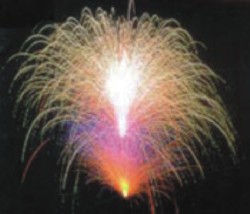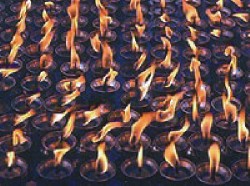| |
Diwali
in Dhaka
A
Time for Joy
Kavita Charanji
 I
was back home in Dhaka just in time to celebrate Diwali
with old friends. It was time again to clean up the house
till it is speckless; time for playing cards, buying Diwali
gifts, exquisite diyas and candles from Aarong; for gorging
on sweetmeats and dry fruit. And most of all it's a time
of exhilaration for children as they splurge on firecrackers
-- anars, rockets, sparklers. I
was back home in Dhaka just in time to celebrate Diwali
with old friends. It was time again to clean up the house
till it is speckless; time for playing cards, buying Diwali
gifts, exquisite diyas and candles from Aarong; for gorging
on sweetmeats and dry fruit. And most of all it's a time
of exhilaration for children as they splurge on firecrackers
-- anars, rockets, sparklers.
As happens
every year, the Dhaka Indian women's Organisation (DIWA)
organised a Diwali Mela prior to the big day on October
25. Young Indian children put up a delightful skit with
a scene from the Ramayana (the epic which depicts the victory
of Prince Ram over the ten-headed demon king Ravana and
the rescue of his wife Sita from the clutches the evil king).
Diwali is celebrated every year to mark the return of Ram,
Sita and Lakshman (Ram's brother) from 14-years of exile
and their return to their kingdom of Ayodhya. The ladies
also performed the Ganesh Vandana, an invocation to Ganesh,
the elephant God. Another highlight of the evening was the
rendering of the rumbustious Punjabi folk dance, called
the Gidda.
The
big day dawned early for most Indians, despite the  endless
rounds of parties and cards (flush, a popular Diwali card
game). Gifts were exchanged among friends, children were
excited and the grown ups in Dhaka were equally in a festive
mood. Come evening and houses were lit up brightly with
sparkling lights, which could catch the eyes of neighbours
and devotees performed the Lakshmi Puja to win the favour
of the goddess of wealth. endless
rounds of parties and cards (flush, a popular Diwali card
game). Gifts were exchanged among friends, children were
excited and the grown ups in Dhaka were equally in a festive
mood. Come evening and houses were lit up brightly with
sparkling lights, which could catch the eyes of neighbours
and devotees performed the Lakshmi Puja to win the favour
of the goddess of wealth.
Back
in New Delhi, my hometown, the newspapers were full of write-ups
on Diwali. In an evocative piece last year in the daily
Indian Express, Renuka Narayanan, a wellknown columnist,
recounted her experiences of the Festival of Lights. To
quote Renuka: “Diwali has the power to renew our spirit
and give us the mental energy to carry on. I saw a gallant
example of this in Mumbai: a beggar carefully lit a single
diya to illumine his patch of pavement. Equally powerful
is the memory of Hardwar of a gaunt, dusty farmer setting
a solitary diya afloat on the Ganga. It was a heart-stopping
scene. He was so reverent, yet dignified --what pain and
hardship did he want the Mother River to heal? Or perhaps
he gave thanks? Who won't feel weepy at such sights?”
 At
these times I cannot help reminiscing my own Diwalis during
my younger days, the memories of tucking away a grand sum
of Rs 10 to buy snake tablets (which transform into snake-like
figures), buying spanking new clothes for the big day, bursting
hand bombs with friends, lighting the diyas and candles
with sparklers called phuljaris, scaring the neighbourhood
dogs with loud bombs and rockets and feasting on laddoos
and dry fruit. I was invariably lucky at cards and managed
to make a tidy sum at the game of flush. At
these times I cannot help reminiscing my own Diwalis during
my younger days, the memories of tucking away a grand sum
of Rs 10 to buy snake tablets (which transform into snake-like
figures), buying spanking new clothes for the big day, bursting
hand bombs with friends, lighting the diyas and candles
with sparklers called phuljaris, scaring the neighbourhood
dogs with loud bombs and rockets and feasting on laddoos
and dry fruit. I was invariably lucky at cards and managed
to make a tidy sum at the game of flush.
Now
Diwali is more sober in New Delhi. Though there is ostentatious
spending in some quarters, on the whole it is a more subdued
occasion -- largely due to the efforts of Indian NGOs which
have raised public awareness on the child labour-centred
fireworks industry in South India. Yet, the fire engines
are on alert, as there are invariable fires in some pockets
of the city.
And
now that Diwali is over, there's still so much to look forward
to -- Eid, Christmas and New Year. Who said the party's
over?
|

 I
was back home in Dhaka just in time to celebrate Diwali
with old friends. It was time again to clean up the house
till it is speckless; time for playing cards, buying Diwali
gifts, exquisite diyas and candles from Aarong; for gorging
on sweetmeats and dry fruit. And most of all it's a time
of exhilaration for children as they splurge on firecrackers
-- anars, rockets, sparklers.
I
was back home in Dhaka just in time to celebrate Diwali
with old friends. It was time again to clean up the house
till it is speckless; time for playing cards, buying Diwali
gifts, exquisite diyas and candles from Aarong; for gorging
on sweetmeats and dry fruit. And most of all it's a time
of exhilaration for children as they splurge on firecrackers
-- anars, rockets, sparklers. endless
rounds of parties and cards (flush, a popular Diwali card
game). Gifts were exchanged among friends, children were
excited and the grown ups in Dhaka were equally in a festive
mood. Come evening and houses were lit up brightly with
sparkling lights, which could catch the eyes of neighbours
and devotees performed the Lakshmi Puja to win the favour
of the goddess of wealth.
endless
rounds of parties and cards (flush, a popular Diwali card
game). Gifts were exchanged among friends, children were
excited and the grown ups in Dhaka were equally in a festive
mood. Come evening and houses were lit up brightly with
sparkling lights, which could catch the eyes of neighbours
and devotees performed the Lakshmi Puja to win the favour
of the goddess of wealth. At
these times I cannot help reminiscing my own Diwalis during
my younger days, the memories of tucking away a grand sum
of Rs 10 to buy snake tablets (which transform into snake-like
figures), buying spanking new clothes for the big day, bursting
hand bombs with friends, lighting the diyas and candles
with sparklers called phuljaris, scaring the neighbourhood
dogs with loud bombs and rockets and feasting on laddoos
and dry fruit. I was invariably lucky at cards and managed
to make a tidy sum at the game of flush.
At
these times I cannot help reminiscing my own Diwalis during
my younger days, the memories of tucking away a grand sum
of Rs 10 to buy snake tablets (which transform into snake-like
figures), buying spanking new clothes for the big day, bursting
hand bombs with friends, lighting the diyas and candles
with sparklers called phuljaris, scaring the neighbourhood
dogs with loud bombs and rockets and feasting on laddoos
and dry fruit. I was invariably lucky at cards and managed
to make a tidy sum at the game of flush.